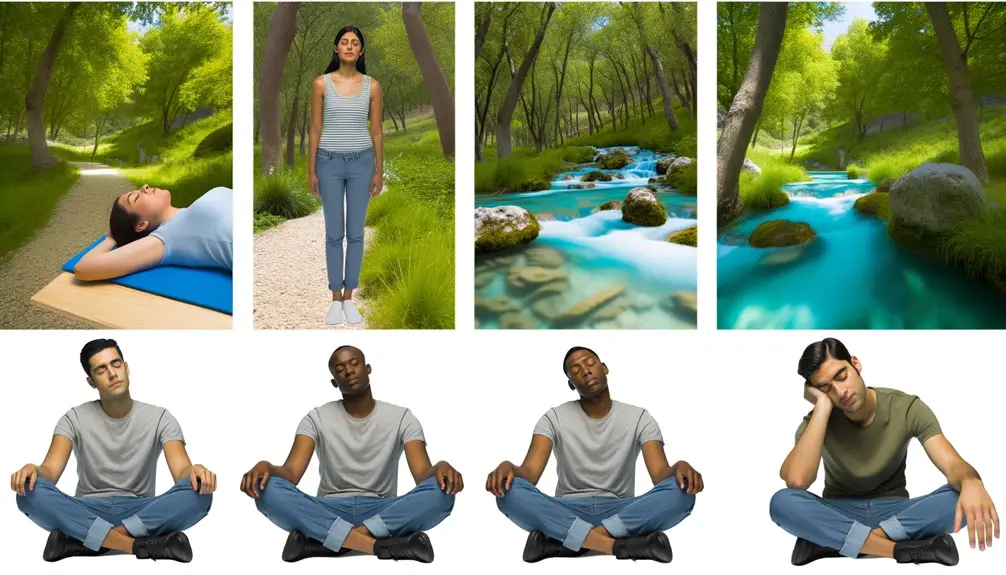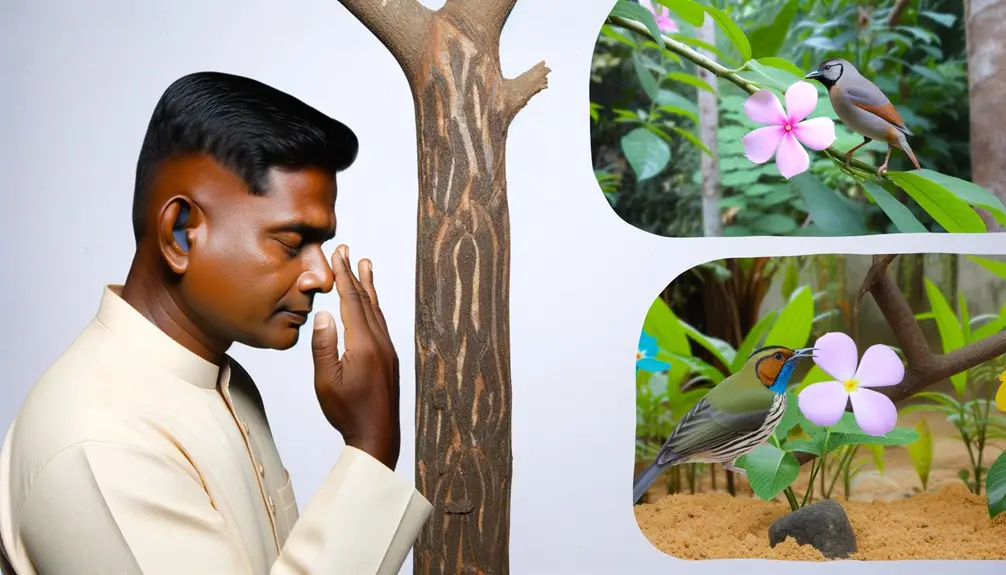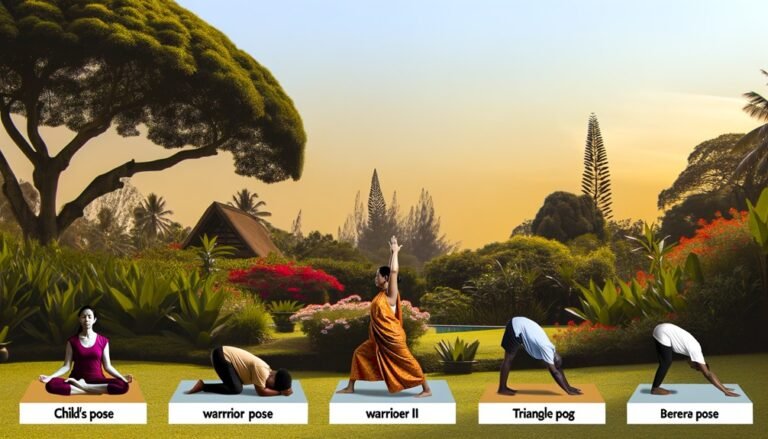As you navigate the hustle and bustle of daily life, the concept of being present may seem like a distant ideal. However, imagine the transformative power of grounding yourself in the current moment, allowing stress to dissipate and clarity to emerge. Each technique presented in this comprehensive guide offers a unique approach to mindfulness, promising a pathway to inner peace and resilience. From deep breathing exercises to gratitude journaling, these practices hold the key to unlocking a calmer, more centered version of yourself. Are you ready to embark on this journey towards reducing stress and embracing mindfulness in your everyday life?
Key Takeaways
- Practice deep breathing techniques to manage stress effectively and engage the parasympathetic nervous system.
- Incorporate body awareness through techniques like body scanning to promote relaxation and mindfulness.
- Engage in mindful movement practices like mindful walking to reduce stress and cultivate peace.
- Cultivate gratitude through practices like journaling to boost well-being, enhance mood, and reduce stress.
- Use visualization exercises to create a tranquil mental landscape, reduce stress, and strengthen the mind-body connection.
The Importance of Being Present

Embrace the practice of grounding yourself in the present moment to cultivate mindfulness and reduce stress. Start by integrating mindful eating into your routine. This practice involves savoring each bite, being aware of the flavors and textures, and listening to your body's hunger cues. The benefits of mindfulness while eating include better digestion, improved relationship with food, and increased satisfaction from meals.
Furthermore, honing mindful communication skills is crucial in today's fast-paced world. When engaging in conversations, the importance of presence can't be overstated. Being fully attentive to the person speaking, maintaining eye contact, and actively listening without judgment are key elements. This not only fosters deeper connections but also enhances mutual understanding and empathy.
Deep Breathing Exercises

When it comes to managing stress, deep breathing exercises can be a game-changer.
These techniques not only help you relax but also bring a host of benefits to your overall well-being.
Let's explore how deep breathing can be your stress-busting ally.
Benefits of Deep Breathing
Experience the calming effects of deep breathing exercises through simple yet powerful techniques. Deep breathing is a cornerstone of mindfulness practices, promoting relaxation and reducing stress levels effectively. By focusing on your breath, you can anchor yourself in the present moment, fostering a sense of calm and clarity.
Mindful breathing can also enhance your awareness of bodily sensations, aiding in stress management and promoting overall well-being. Taking deep breaths engages the parasympathetic nervous system, triggering a relaxation response that counteracts the body's stress response.
Incorporating deep breathing exercises into your daily routine, especially during moments of tension or overwhelm, can help you regain composure and approach challenges with a clearer mind. Embrace the benefits of deep breathing for a more balanced and centered life.
Techniques for Relaxation
Discover the power of deep breathing exercises as effective techniques for relaxation and stress reduction. Deep breathing is a simple yet powerful tool to calm your mind and body, helping you manage stress and anxiety more effectively. By practicing deep breathing exercises, you can engage your parasympathetic nervous system, triggering a state of relaxation. Here is a table to explore further relaxation techniques:
| Technique | Description | Benefits |
|---|---|---|
| Guided Imagery | Use mental images to promote calm | Reduces stress and enhances mindfulness |
| Progressive Relaxation | Tense and relax muscle groups | Promotes physical and mental relaxation |
Integrating these techniques into your daily routine can enhance your overall well-being and help you combat stress more effectively.
Body Scan Technique

Engage in the Body Scan Technique to systematically focus on different parts of your body, promoting relaxation and mindfulness. This practice offers a myriad of benefits to your overall well-being and serves as a cornerstone of mindfulness practice. By bringing your attention to each part of your body, starting from your toes all the way up to the top of your head, you can cultivate a deep sense of awareness and presence in the moment. The body scan technique allows you to release tension, reduce stress, and connect with yourself on a profound level.
Through this practice, you can uncover areas of tension or discomfort in your body that you may not have been aware of before, enabling you to address them with care and kindness. As you scan through each body part, you're encouraged to observe any sensations without judgment, simply acknowledging them and allowing them to be. This technique not only enhances your ability to stay present but also fosters a deeper connection between your mind and body, promoting holistic well-being. Start incorporating the body scan technique into your daily routine to experience its transformative effects on your mindfulness journey.
Mindful Walking Practice

While taking a walk, focus on each step and your surroundings to practice mindfulness through the Mindful Walking technique. This practice encourages you to engage in mindful movement by paying close attention to the sensations in your body as you walk. Notice how your feet connect with the ground, the rhythm of your steps, and the movement of your body.
Embrace the nature connection by observing the environment around you – the rustling of leaves, the chirping of birds, or the gentle breeze against your skin. Allow yourself to fully immerse in the present moment without judgment or distraction.
Mindful walking can be a powerful way to center yourself and reduce stress. As you walk, let go of any racing thoughts and simply be with your experience. This technique not only promotes physical activity but also cultivates a sense of calm and clarity.
Try incorporating mindful walking into your routine to bring a sense of peace and awareness to your day.
Gratitude Journaling

You can boost your well-being by starting a gratitude journal. Reflecting on things you're thankful for can shift your focus from stress to positivity.
Begin by jotting down a few things each day that you appreciate.
Benefits of Gratitude
Practicing gratitude journaling can significantly boost your mental well-being and reduce stress levels. Keeping a gratitude journal involves regularly writing down things you are thankful for, which can enhance your overall outlook on life. Here are some benefits and practices to consider:
| Benefits of Gratitude | Gratitude Journaling Practices |
|---|---|
| Enhances mood | Write 3 things you're grateful for daily |
| Reduces stress | Reflect on positive experiences |
| Improves relationships | Include acts of kindness you've received |
| Increases resilience | Express gratitude towards yourself |
| Enhances overall well-being | Use specific details in your entries |
How to Start
To initiate gratitude journaling effectively, start each day by reflecting on three specific things you're grateful for. This practice sets a positive tone for your day, fostering a mindset of appreciation and mindfulness.
As you jot down these moments of gratitude, try to delve deep into why each one resonates with you. Engaging in mindful eating can also enhance your journaling experience. Take time to savor each bite, focusing on the flavors and textures.
Additionally, incorporating grounding exercises into your routine can help center your thoughts and emotions, making it easier to connect with the things you're thankful for. By combining these practices, you can cultivate a profound sense of gratitude and reduce stress in your daily life.
Progressive Muscle Relaxation

Engage in Progressive Muscle Relaxation by systematically tensing and then relaxing different muscle groups in your body to reduce stress and promote relaxation. This technique is a powerful way to release built-up muscle tension, a common physical response to stress. By focusing on each muscle group individually, you bring awareness to areas where stress may be stored and consciously release it.
Progressive Muscle Relaxation works by tensing a specific muscle group for a few seconds and then releasing the tension, allowing the muscle to relax fully. This process encourages a deep sense of relaxation throughout the body, helping to alleviate both physical and mental tension. Regular practice of this technique can improve your overall sense of well-being and help you manage stress more effectively.
Incorporating Progressive Muscle Relaxation into your daily routine can provide a quick and effective way to unwind and de-stress. Whether you practice it before bed to promote better sleep or during a work break to reset your mind, this technique offers a simple yet powerful tool for relaxation and stress relief.
Loving-Kindness Meditation

Embrace the practice of Loving-Kindness Meditation to cultivate compassion and reduce stress in your life.
By focusing on sending love and goodwill to yourself and others, you can experience a sense of interconnectedness and inner peace.
Learn how to incorporate this technique into your daily routine for a more positive and fulfilling mindset.
Benefits of Kindness
Practicing loving-kindness meditation can lead to a greater sense of compassion and empathy towards yourself and others. This form of compassion meditation focuses on cultivating feelings of love and kindness. Research suggests that engaging in loving-kindness meditation can increase positive emotions and lead to more altruistic behavior.
How to Practice
To cultivate feelings of love and kindness through loving-kindness meditation, focus on visualizing yourself and others bathed in a warm, radiant light of compassion. This practice involves sending well-wishes to yourself, loved ones, acquaintances, and even those with whom you may have conflicts.
As you sit quietly, let your mind dwell on phrases like 'May you be happy,' 'May you be healthy,' and 'May you live with ease.' By incorporating mindful eating into your routine, savor each bite, paying attention to textures, flavors, and sensations.
Engage in mindful communication by actively listening to others without judgment, speaking kindly, and being fully present in conversations. Try integrating these practices into your daily life to enhance your overall well-being.
Sensory Awareness Technique

Engage your senses fully to bring yourself into the present moment with the Sensory Awareness Technique. This mindfulness practice involves focusing on sensory grounding to enhance your awareness of the here and now.
One effective way to apply this technique is through mindful eating, which can significantly contribute to stress reduction. When you eat mindfully, pay attention to the colors, textures, and flavors of your food. Notice the sensation of each bite as you chew slowly and savor every moment.
By engaging in this sensory experience, you not only nourish your body but also cultivate a deeper connection with the present moment. Practice mindful eating regularly to develop a heightened sense of awareness and reduce stress levels effectively.
Embracing the Sensory Awareness Technique through mindful eating is a simple yet powerful way to anchor yourself in the present and promote overall well-being.
Visualization Exercise

Immerse yourself in a tranquil mental landscape with the Visualization Exercise. This technique involves using guided imagery and mental focus to create a powerful tool for stress reduction. By engaging in creative visualization, you can transport your mind to a peaceful setting, promoting relaxation and clarity.
To begin the Visualization Exercise, find a quiet space where you can sit or lie down comfortably. Close your eyes and take a few deep breaths to center yourself. Now, imagine a serene scene in vivid detail. Use all your senses to enhance the experience:
| Visualization Exercise | |
|---|---|
| Guided Imagery | Imagine a lush forest with sunlight filtering through the leaves. Feel the soft moss beneath your feet and hear the gentle rustle of the trees. |
| Mental Focus | Direct your attention to the intricate details of this mental landscape, allowing yourself to fully immerse in the experience. |
| Creative Visualization | Picture yourself releasing any tension or worries into the surroundings, feeling lighter and more at peace. |
Practice this exercise regularly to strengthen your mind-body connection and experience profound relaxation.
Practical Tips to Implement Today

Consider incorporating these practical techniques into your daily routine to reduce stress and boost your well-being. Start your day with a mindful morning routine. Instead of reaching for your phone right away, take a few deep breaths, stretch your body, and set positive intentions for the day ahead. Throughout the day, practice mini-mindfulness sessions. Take short breaks to focus on your breath, observe your surroundings, and check in with your emotions. These moments of daily mindfulness can help you stay grounded and calm amidst chaos.
Another effective stress relief technique is to incorporate mindfulness into everyday activities. Whether you're washing dishes, walking to work, or eating a meal, try to stay fully present in the moment. Engaging your senses and focusing on the task at hand can prevent your mind from wandering into stressful thoughts. Additionally, practicing gratitude daily can shift your perspective and cultivate a sense of appreciation for the present moment. Take a few moments each day to reflect on what you're thankful for, whether big or small. These simple yet powerful practices can make a significant difference in your overall well-being.
Conclusion
In conclusion, by incorporating mindfulness techniques into your daily routine, you can effectively reduce stress and improve your overall well-being.
Remember to take a moment to breathe deeply, practice body scans, engage in mindful walking, keep a gratitude journal, and meditate with loving-kindness.
These simple yet powerful practices can help you stay present, manage stress, and cultivate a sense of inner peace starting today.
Embrace the power of mindfulness and watch as your stress levels decrease and your quality of life improves.




